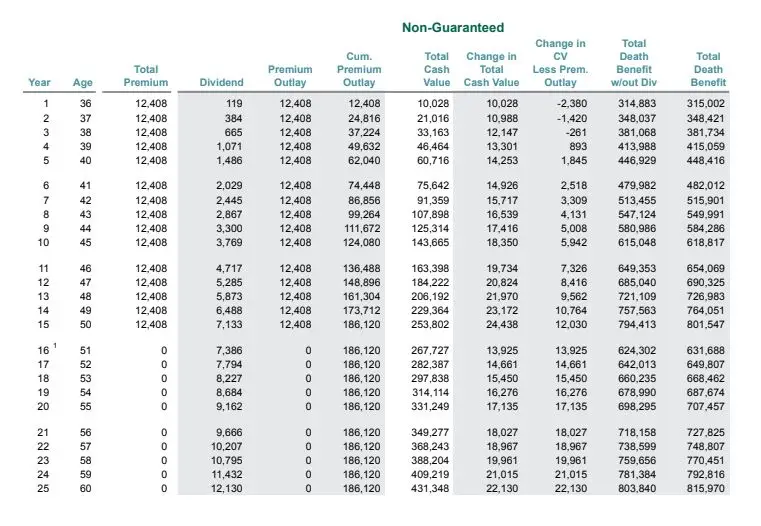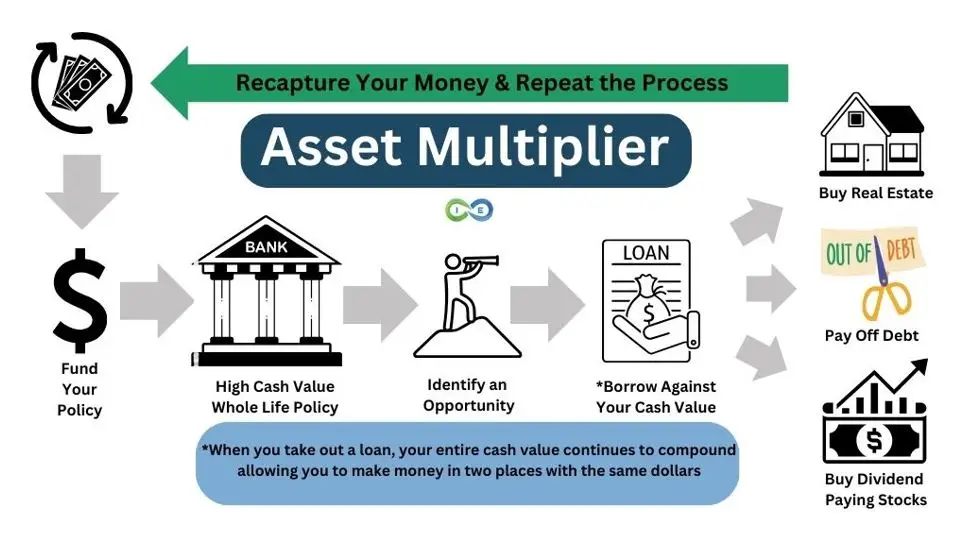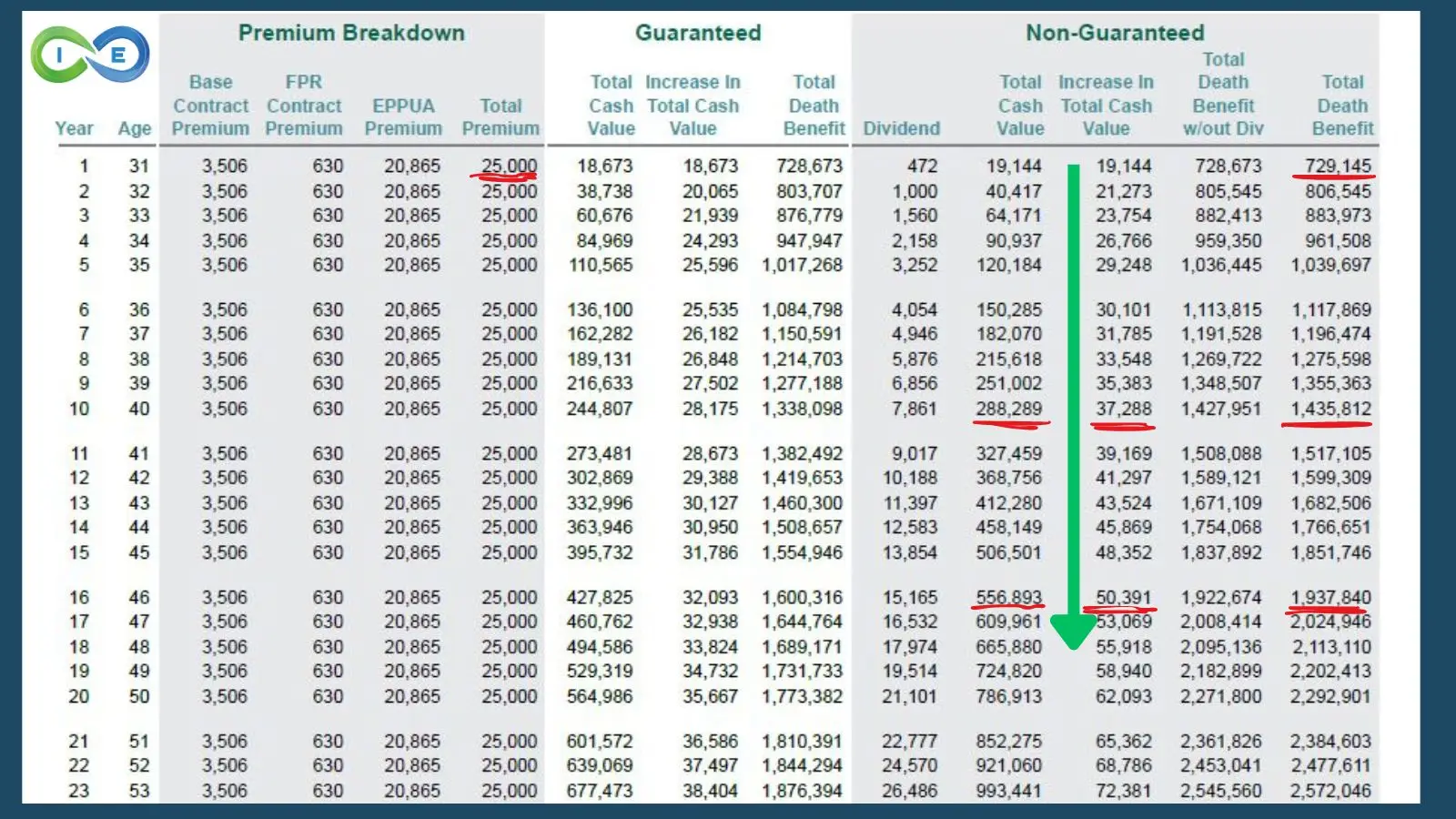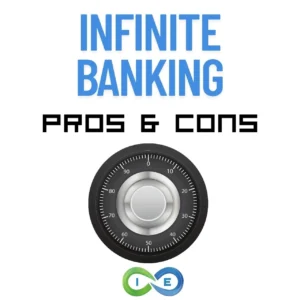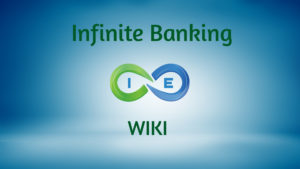In the realm of personal finance, few decisions loom as large as how to handle mortgage debt. For many homeowners, the allure of paying off their mortgage early is strong. After all, who wouldn’t want to own their home outright and be free from monthly payments? However, in the complex world of modern finance, what seems intuitive isn’t always the most financially advantageous path.
This article will explore an alternative strategy: using the money you might put towards early mortgage payments to instead fund a high cash value whole life insurance policy. We’ll examine the pros and cons of each approach, with a particular focus on security, risk management, and long-term financial growth.
Table of Contents
- The Saver’s Dilemma in Our Current Financial System
- The Appeal of Paying Off Your Mortgage Early
- The Whole Life Insurance Alternative
- The Macroeconomic Perspective: Inflation and the Saver’s Dilemma
- Conclusion: Your Personal Financial Strategy
The Saver’s Dilemma in Our Current Financial System
Before we delve into the specifics of mortgage payoff strategies, it’s crucial to understand a fundamental challenge faced by savers in our current economic environment. Our financial system, with its tendency towards inflation and low interest rates, often punishes those who prioritize saving. Traditional savings accounts and many conservative investments struggle to keep pace with inflation, resulting in a loss of purchasing power over time.
This reality leaves many financially prudent individuals in a quandary. They desire the security and peace of mind that comes with saving, but they also need their money to work for them and grow over time. It’s in this context that we need to evaluate the decision of paying off a mortgage early.
The Appeal of Paying Off Your Mortgage Early
Advantages:
- Emotional Relief: There’s an undeniable psychological benefit to being debt-free. Eliminating a mortgage can lift a significant mental burden.
- Increased Budgeting Flexibility: Without a mortgage payment, you have more discretionary income each month.
- Interest Savings: Every dollar applied to principal is not accruing future interest, potentially saving hundreds of thousands over the life of the loan.
- Simplified Finances: Owning your home outright can make it easier to sell or refinance in the future.
- Reduced Foreclosure Risk: With no mortgage, you eliminate the risk of losing your home due to missed payments.
The Hidden Costs of Early Mortgage Payoff
While these advantages are significant, there are several drawbacks to consider:
- Opportunity Cost: Every dollar used to pay down your mortgage is a dollar not invested elsewhere, potentially missing out on higher returns.
- Loss of Tax Deductions: Mortgage interest is tax-deductible for those who itemize, though recent tax law changes have made this less impactful for many homeowners.
- Reduced Liquidity: Home equity is not easily accessible. Tapping into it usually requires selling the home or taking out a new loan.
- Suboptimal Use of Funds: If your mortgage interest rate is low (as many have been in recent years), you might earn a better return by investing elsewhere.
- No Additional Protection: Paying off your mortgage doesn’t provide any additional insurance or death benefit protection for your family.
- Increased Vulnerability: With more of your wealth tied up in your home, you’re more exposed to real estate market fluctuations and potential disasters.
For example, if the real estate market drops, your home’s market value could drop significantly. Also, if your home is destroyed in a fire you may have a tough time recovering enough payout from home owners insurance policy to cover it.
Equity Doesn’t Equal ROI: A Critical Consideration
Before we explore the alternative strategy using whole life insurance, it’s crucial to understand a fundamental concept about home equity: Equity doesn’t equal Return on Investment (ROI).
Many homeowners rush to pay off their mortgages, believing that increasing their home equity will somehow boost their overall returns. However, this is a common misconception. The appreciation of your home – which is your actual return on investment – is not affected by how much equity you have.
Consider this example:
Imagine two identical homes in the same neighborhood, both valued at $300,000:
- Home A has a $200,000 mortgage (33% equity)
- Home B is owned free and clear (100% equity)
If property values in the area increase by 5% over the year, both homes will appreciate to $315,000, regardless of the equity position. The owner of Home A gains $15,000 in appreciation with only $100,000 tied up in the house, while the owner of Home B gains the same $15,000 but with $300,000 tied up in the house.
This illustrates a crucial point: Your home’s return on investment is based on its total value, not your equity. Paying down your mortgage faster doesn’t increase your home’s rate of appreciation.
By understanding this concept, we can see that aggressively paying down a mortgage might not be the most efficient use of your money. It doesn’t increase your returns, and it ties up your wealth in an illiquid asset.
Would You Fire a Profitable Employee?
Before we explore the whole life insurance alternative, let’s reframe how you think about your mortgage using a simple business analogy.
Imagine you’re a business owner and you have an employee you pay $40,000 per year. That employee generates $80,000 in annual returns for your business. Would you fire that employee to “save” the $40,000 salary expense?
Of course not. That would be terrible business sense. You’re netting $40,000 in profit from that employee’s work.
Your mortgage works the same way.
When you have a mortgage at 5% interest and you’re earning higher returns on invested capital in your whole life policy, your mortgage isn’t a burden, it’s a profitable employee. The mortgage interest you pay is the “salary,” and the returns you earn on deployed capital are the “revenue.”
By rushing to pay off your mortgage early, you’re essentially “firing” this profitable employee. You eliminate the interest expense, but you also eliminate the opportunity to earn returns on that capital.
This doesn’t even account for the additional opportunities that come from having $500,000 in liquid, accessible capital that you can borrow against to acquire income-producing assets.
The question isn’t whether you can pay off your mortgage. The question is whether you should, given the opportunity cost of tying up that capital in an illiquid asset that generates no additional returns.
The Whole Life Insurance Alternative
Instead of paying extra on your mortgage, consider directing those funds into whole life insurance. And not just any whole life policy but a high cash value whole life insurance policy. These are strategically designed policies that focus on cash value growth versus the death benefit and provide much better returns than traditional policies.
Advantages of Whole Life Insurance:
- Guaranteed Returns: Properly designed whole life policies offer guaranteed cash value growth, with potential for higher returns through dividends.
- Tax Advantages: Cash value grows tax-deferred, and loans against the policy can be taken tax-free.
- Liquidity: Cash value can be accessed tax-free through policy loans or withdrawals up to your basis (amount you paid in).
- Death Benefit: A properly designed whole life policy has a growing death benefit that provides additional financial protection for your family.
- Asset Protection: In many states, life insurance cash values are protected from creditors. Get sued and have a judgment against you? Based on your jurisdiction, your entire cash value may be protected.
- Infinite Banking Concept: Use your policy as your own “bank” to finance purchases and investments, recapturing interest you’d otherwise pay to traditional banks.
Real-World Case Study: Liquidity Protection During the 2008 Housing Crisis
In December 2007, a financial strategist who understood these principles refinanced his personal residence, valued at $1.5 million at 100% loan-to-value. He extracted all equity and placed it into liquid cash value life insurance policies earning guaranteed returns.
What happened next?
By 2008, his home’s market value had dropped to $1.1 million, a $400,000 decline. Critics argued he was “underwater,” owing more than the home was worth.
But did he lose money? No.
The $400,000 he had extracted wasn’t trapped in the declining real estate. It was safely positioned in his cash value policies, continuing to earn returns. Meanwhile, he used the earnings from these policies to comfortably make his mortgage payments.
The comparison:
- Homeowner with equity trapped: Guaranteed loss of $400,000 in home value. No access to that equity without selling at the worst possible time or trying to refinance when banks weren’t lending.
- Homeowner with liquid strategy: Zero loss. His $400,000 was protected, liquid, and earning returns. His mortgage lenders were happy because he had more than enough assets to service the debt.
This illustrates an important principle: home equity provides no protection against market downturns. Whether your home is mortgaged or paid off, it will decline in value during a market crash. The difference is whether you have your wealth trapped in that declining asset or positioned in a liquid, protected vehicle.
Homeowners who lost their properties to foreclosure during 2008-2010 weren’t those with high loan-to-value ratios and liquid reserves. They were those who lost income, had their equity trapped, and couldn’t access capital when they needed it most.
This real-world example illustrates why we need to rethink what being ‘out of debt’ actually means.
Rethinking What “Out of Debt” Really Means
Most people define being “out of debt” as owing nothing to anyone. By this definition, you’re only debt-free when your mortgage balance hits zero.
However, wealthy individuals and savvy business owners use a different definition, one based on their balance sheet rather than their emotional relationship with debt.
The Investor’s Definition of “Out of Debt”: You’re out of debt when you have enough liquid assets that you could pay off all your liabilities at any time with a simple phone call or electronic transfer.
Two Scenarios:
Person A:
- $500,000 home, fully paid off
- $50,000 in savings
- Total net worth: $550,000
- Liquid assets: $50,000
Person B:
- $500,000 home with $400,000 mortgage
- $450,000 in whole life cash value
- Total net worth: $550,000 ($500k home + $450k cash value – $400k mortgage)
- Liquid assets: $450,000
Who is actually “out of debt” by the investor’s definition? Person B clearly meets the investor’s definition while maintaining superior optionality. Person A technically has no debt, but Person B has both financial freedom AND flexibility.
More importantly, Person B can borrow up to $400,000 (90% of cash value) against their policy tomorrow to acquire an income-producing asset, without selling anything, without bank approval, and while their full cash value continues compounding. Person A’s equity is trapped, earning zero return, and can only be accessed by selling or refinancing, often when they need it most and when terms are least favorable.
This shift in perspective, from “owing nothing” to “having control,” is fundamental to understanding why sophisticated investors often maintain mortgages even when they could easily pay them off.
Case Study 15 Year versus 30 Year Mortgage
To better illustrate how this strategy works in practice, let’s look at a detailed case study. In the following video, we break down the numbers comparing a 15-year mortgage payoff strategy with a 30-year mortgage combined with a whole life insurance policy:
You can view the illustration from the video below
As demonstrated in this video case study, the strategy of combining a 30-year mortgage with a whole life insurance policy can potentially lead to significant wealth accumulation over time. Let’s explore this concept further with the Asset Multiplier Approach.
THE ULTIMATE FREE DOWNLOAD
The Self Banking Blueprint
A Modern Approach To The Infinite Banking Concept
The Asset Multiplier Approach
One powerful strategy is called the Asset Multiplier Blueprint. You use your whole life policy’s cash value as an opportunity fund to acquire more assets. Here’s how it works:
- Fund your policy over time, building up cash value, your “opportunity fund.”
- Take a loan against your cash value to purchase income-producing assets (e.g., rental properties, businesses).
- Use the income from these assets to repay the policy loan and continue funding the policy.
- Repeat the process, potentially accelerating your wealth growth.
This approach allows you to leverage your policy’s cash value to acquire assets that can generate returns higher than the policy loan interest rate, all while maintaining your growing death benefit protection.
Unlike a paid-off house, a whole life policy can act as an “opportunity fund” to help you acquire income-producing assets. Here’s a simplified example:
1. Instead of putting an extra $20,000/year towards your mortgage, you fund a whole life policy.
2. After several years, you’ve built up substantial cash value.
3. You can then borrow against this cash value to invest in a rental property. The rental income can be used to repay the policy loan and continue funding the policy.
4. Meanwhile, your policy’s cash value and death benefit continue to grow.
5. Your home also continues to appreciate.
This strategy allows you to:
a) Maintain mortgage interest tax deductions (if applicable)
b) Keep your money liquid and accessible
c) Potentially earn returns from multiple assets (policy, investments, home appreciation)
d) Provide growing death benefit protection for your family
By using whole life insurance this way, you’re not just eliminating debt – you’re actively building wealth while protecting your family’s financial future.
Potential Drawbacks of a Whole Life Insurance Strategy
While high cash value whole life insurance offers numerous benefits as a financial tool, it’s crucial to understand the potential drawbacks and risks associated with this strategy:
- Higher Premiums: Whole life insurance premiums are significantly higher than term life insurance premiums for the same death benefit amount. This higher cost can strain your budget, especially in the early years of the policy. However, these policies do offer superb premium flexibility which provides a lot of financial cushion if money gets tight.
- Complexity: Whole life policies are more complex than term life policies or simple savings accounts. Understanding the nuances of cash value growth, dividends, and policy loans requires financial literacy and often professional guidance, which is why our team provides lifetime coaching to our clients.
- Policy Loans: While the ability to take loans against your policy’s cash value is a key benefit of whole life insurance, failing to manage these loans properly can lead to significant issues.
Life Stages and Strategy Effectiveness
This strategy is particularly powerful for younger individuals with a longer time horizon. Here’s why:
Compound Growth: The earlier you start, the more time your cash value has to grow in a true uninterrupted compound interest environment.
Lower Insurance Costs: Younger policyholders typically pay lower whole life insurance premiums for the same coverage.
Longer Investment Horizon: With 30+ years ahead, you have more time to implement the asset multiplier strategy and recover from any market downturns.
Changing Financial Needs: As you age, your life insurance needs may decrease, but your policy’s cash value can transition to serve other financial purposes, such as using it for tax-free retirement income. And your growing death benefit is a permission slip to use other assets and still leave an inheritance.
Whole Life Insurance Example
In this example we have Chris. He is 30 years old and is funding a whole life insurance policy with $25,000 a year versus paying off his mortgage early. As you can see from the illustration below, the first year Chris makes a premium payment he already has a $729,145 death benefit, which would most likely pay off his mortgage and then some. As the years go by, Chris’s cash value grows rapidly.
In year 10, his cash value is $288,289. And by year 16 it has ballooned to over $556,000. This is ready cash in his opportunity fund that he can borrow against to buy other assets, instead of having his money locked into his home equity doing nothing for him.
Also, notice his death benefit continues to grow each year. So he gets the best of both worlds. He gets the appreciation of his home, growing around 3-5% a year and the growing death benefit and cash value in his whole life insurance policy.
Current Economic Considerations
As of 2024, interest rates have risen significantly from their historic lows. This affects the mortgage vs. whole life decision in several ways:
Higher Mortgage Rates: Make the idea of paying off high-interest debt more attractive so many savers fail to consider alternatives.
Increased Whole Life Returns: Many policies are now offering guaranteed cash value growth with potential for higher total returns through dividends.
Volatile Market Conditions: Whole life is a volatility buffer shielding you from the volatility of the stock market and protecting you from sequence of returns risk. The value of guaranteed returns and death benefit protection offered by whole life insurance cannot be understated.
Maximize Your Wealth with a Whole Life Insurance Strategy
Uncertain whether to pay off your mortgage early or invest in a high cash value whole life insurance policy? Schedule a complimentary consultation with our financial experts to explore the Asset Multiplier Approach and optimize your financial future.
- ✓ Receive a personalized comparison of mortgage payoff vs. whole life insurance strategies
- ✓ Learn how to leverage cash value for tax-advantaged wealth growth
- ✓ Understand the infinite banking concept and asset protection benefits
- ✓ Get tailored projections to align with your financial goals and risk tolerance
Conclusion: Your Personal Financial Strategy
While we’ve explored the pros and cons of paying off your mortgage early versus investing in a high cash value whole life insurance policy, the best decision for you depends on your unique financial situation, goals, and risk tolerance. There’s no one-size-fits-all solution in personal finance.
The most effective way to determine the right strategy for your circumstances is to run your own numbers with the guidance of an experienced professional. We invite you to schedule an appointment for a free strategy session with a member of our team. During this session, we can:
- Analyze your current financial situation
- Discuss your long-term financial goals
- Compare personalized projections for both strategies
- Answer any questions you may have about whole life insurance or mortgage strategies
- Help you develop a tailored plan that aligns with your objectives
Don’t leave your financial future to guesswork. Take the first step towards a comprehensive financial strategy today. Schedule your free strategy session with one of our Pro Client Guides now, and let’s work together to create a plan that maximizes your financial potential and provides the security and growth you’re looking for.
Book your free 30-minute financial strategy session today and discover how to build wealth while protecting your family.
No obligation. No pressure. Just expert guidance to help you decide the best path for your financial security and growth.
Frequently Asked Questions About Mortgage Payoff vs. Whole Life Insurance
Why might investing in whole life insurance be better than paying off my mortgage early?
Investing in a high cash value whole life insurance policy can offer tax-deferred growth, liquidity through policy loans, a growing death benefit, and asset protection, which may provide greater financial flexibility and wealth-building potential compared to tying up funds in home equity, which is illiquid and doesn’t increase your home’s appreciation rate.
What are the risks of using whole life insurance instead of paying off my mortgage?
Risks include higher premiums compared to term life insurance, complexity in managing cash value and policy loans, and the need for financial discipline to avoid mismanaging loans, which could reduce policy benefits. However, properly designed policies offer premium flexibility and professional guidance can mitigate these risks.
How does the Asset Multiplier Approach work with whole life insurance?
The Asset Multiplier Approach involves using the cash value of a whole life policy as an “opportunity fund” to borrow against for purchasing income-producing assets, like rental properties. The income from these assets repays the policy loan, allowing you to continue funding the policy while leveraging multiple assets for wealth growth.
Is whole life insurance a good strategy for older homeowners?
While more effective for younger individuals due to lower premiums and longer compound growth periods, whole life insurance can still benefit older homeowners by providing tax-advantaged cash value for retirement income, a death benefit for legacy planning, and flexibility to adapt to changing financial needs.
How does inflation impact the decision to pay off a mortgage or invest in whole life insurance?
Inflation makes fixed-rate mortgage payments “cheaper” over time, favoring keeping the mortgage, while whole life insurance offers guaranteed returns and a growing death benefit that can provide some inflation protection. However, the policy’s cash value growth may need to be evaluated to ensure it keeps pace with inflation.

